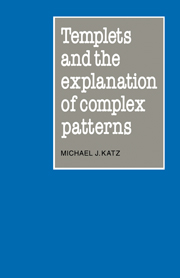Book contents
- Frontmatter
- Contents
- Prologue
- Introduction
- 1 Scientific abstractions
- 2 The nature of explanation
- 3 Configurational explanations
- 4 Templeting
- 5 Self-assembly
- 6 Rules for configurational explanations
- 7 Simple, complex and random
- 8 Reductionism
- Appendix: A pattern theoretic formalization
- Quotation index
- Subject index
2 - The nature of explanation
Published online by Cambridge University Press: 26 March 2010
- Frontmatter
- Contents
- Prologue
- Introduction
- 1 Scientific abstractions
- 2 The nature of explanation
- 3 Configurational explanations
- 4 Templeting
- 5 Self-assembly
- 6 Rules for configurational explanations
- 7 Simple, complex and random
- 8 Reductionism
- Appendix: A pattern theoretic formalization
- Quotation index
- Subject index
Summary
‘What do you mean by that?’ said the Caterpillar, sternly. ‘Explain yourself!’
‘I can't explain myself, I'm afraid, Sir,’ said Alice, ‘because I'm not myself, you see.’
(Alice's Adventures In Wonderland, Chapter V.)Scientific abstractions answer the question: ‘What?’ and, more specifically, they answer the question: ‘What is the exact form of pattern x in the real world?’ Scientific abstractions formally describe the elements and the relations in certain real world patterns; they do so in a manner that maps the abstract realm directly back to the real world; and, in broad terms, this is the meaning of ‘what something is’.
To be precise, however, there is a critical caveat to this simple characterization. Scientific abstractions are called ‘abstractions’ because they abstract certain features from the real world. Abstractions are selected representations; they are not full representations, and they are not the real world items themselves. These are important distinctions, for the only truly complete answer to ‘What is the form of pattern x in the real world?’ is a display of the actual pattern itself [J. Bronowski (1978) The Origins Of Knowledge And Imagination Yale Univ. Press, New Haven]. Any other answer, any rephrasing of pattern x, any reproduction, any metaphor – i.e., any abstraction – implies that we have been at work selectively viewing and, in fact, selectively structuring the real world pattern, and this is unavoidable.
- Type
- Chapter
- Information
- Templets and the Explanation of Complex Patterns , pp. 17 - 32Publisher: Cambridge University PressPrint publication year: 1986



